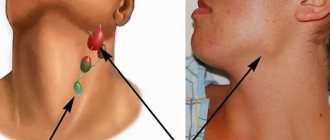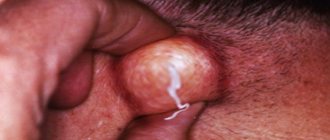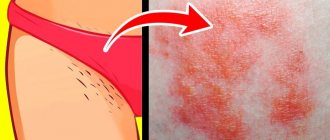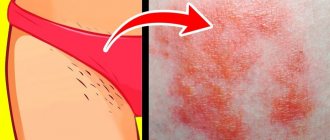The appearance of a ball in the groin area is a reaction of the female body to an internal imbalance in the genitourinary system. Such a change in the structure of the skin may be non-pathogenic in nature, or indicate the development of inflammatory, infectious, or oncological diseases. In order to promptly identify the cause of the appearance of subcutaneous compaction and begin an effective fight against the pathogenic irritant, it is necessary to seek qualified medical help when detecting the first symptoms of changes in the structure and integrity of the skin in the intimate area.
Etiology
The following diseases can provoke the formation of a ball in the groin in women:
- Inflammation of the lymph nodes. Lymph washes all tissues and cells of the body, neutralizing the harmful effects of pathogenic microbes. A large number of lymphatic vessels and nodes through which fluid flows are localized in the groin area. If the lymph cannot cope with aggressive pathogenic microflora, bacterial waste products are not removed from the body and clog the vessels of the lymphatic system. Inflammatory damage to the lymph nodes occurs, accompanied by their enlargement and the formation of subcutaneous lumps.
- Hernia. During physical activity, heavy lifting, or intense strain during coughing or defecation, women may develop an inguinal hernia. The characteristic protrusion is a movable lump under the skin, easy to straighten with your fingers, but it appears again even with slight tone of the peritoneal muscles.
- Varicose veins of the superficial femoral veins. In women who remain in a static position for a long time, undergo heavy physical activity, or during pregnancy, varicose veins of the femoral veins are often observed. The disease manifests itself by the formation of dense and painful pulsating balls under the skin.
- Folliculitis. Inflammation of the hair follicles is manifested by the formation of dense balls - pustules, through the center of which the hair shaft passes.
- Furunculosis. The penetration of pyogenic bacteria (in particular Staphylococcus aureus) into the hair follicles, the surrounding sebaceous glands and connective tissues is accompanied by an acute inflammatory process with the formation of boils - dense balls filled with purulent-necrotic exudate.
- Aneurysm of the femoral artery. Thinning of the walls of the femoral artery often causes the development of pulsating subcutaneous swellings.
- Atheroma. When the sebaceous gland is blocked, caused by the cessation of the outflow of secretions from its excretory canals, benign tumors appear - cysts filled with dead cells and sebum.
- Lipoma. Benign wen in the groin area forms in the layers of connective tissue under the skin. Such a neoplasm does not have a tendency to degenerate into a malignant tumor, but can grow deep into the periosteum through the muscles and vascular bundles.
- Neurofibroma. The development of a benign neoplasm in the soft tissues, formed by the sheaths of nerve endings, is accompanied by the appearance of a dense subcutaneous ball in the groin of women at the site of the tumor.
- Lymphoma. Oncological pathology of lymphatic tissues, in which, as a result of uncontrolled division and accumulation of lymphocytes, the lymph nodes significantly increase in size, is accompanied by the appearance of painless subcutaneous lumps at the site of tumor development.
Any changes in the skin in the intimate area may indicate serious pathological processes in the body. If a ball is detected in the groin of women, even if its appearance is asymptomatic and does not cause discomfort, it is necessary to seek medical help.
Symptoms of nabothian cysts
When they are small, they are not able to lead to the formation of any symptoms. But as they increase in size, Nabothian cysts can alter the menstrual process, preventing the passage of natural blood discharge. Also, in rare cases, large Nabothian cysts can interfere with conception.
For some women, the amount of daily discharge may increase significantly and there will be more mucus in it. But this symptom is common to many other conditions, so it is often not a cause for concern. If such a large cyst bursts, the woman will definitely notice heavy discharge that exceeds the standard.
Ball in the groin of women photo
Causes of compaction formation
A seal on the pubis in men and women signals the development of many pathologies in the body: these can be diseases of the musculoskeletal system, skin and lymphatic diseases. The cause of the development of a lump above or below the pubis can be determined after a comprehensive diagnosis.
The situation may become a little clearer if you familiarize yourself with the general picture of the pathologies that led to the appearance of the swelling. A lump in the pubic area: what is it, what pathologies can be caused - below are the main reasons for the appearance of lumps.
Hernia
If the ball is red and hurts when pressing and walking, this may indicate the development of an inguinal hernia. Men are more susceptible to the disease. Most often, the pathology occurs against the background of frequent overeating and muscle tension.
The subcutaneous neoplasm is initially small in size (from 0.5 to 2 cm). As the hernia progresses, the tumor can grow up to 5 cm. The hernia tumor has a soft consistency, and the pain may intensify upon palpation. It is not possible to eliminate the tumor on your own. If it grows, surgical intervention will be required.
Lipoma
If the ball in the groin does not hurt, this indicates the development of a benign neoplasm - lipoma. Women are more susceptible to the development of pathology (including during pregnancy). A benign ball in the groin area does not harm the patient’s health and does not develop into an oncological tumor. Most often, it measures up to 2-3 cm. Causes of lipoma:
- unhealthy lifestyle: abuse of nicotine products, frequent alcohol consumption, unbalanced diet;
- high blood cholesterol levels;
- hormonal disbalance;
- genetic predisposition.
A small subcutaneous ball, although it does not cause pronounced symptoms, still requires timely treatment. In the early stages, you can get rid of the tumor using topical products. In advanced cases, surgical removal of the lipoma will be required.
Cyst
A ball in the groin in women and men can be a sebaceous cyst. The pathology is formed when the duct of the sebaceous gland is blocked.
A ball-shaped seal in this case appears for the following reasons:
- failure to comply with hygiene standards;
- excessive sweating;
- excess weight and endocrine disorders;
- hormonal disbalance;
- injury to the problem area;
- improper hair removal in women.
The ball under the skin in the groin has a hard consistency. It is easily palpable and begins to cause discomfort upon palpation. Over time, the tumor tends to grow and fester.
A neoplasm with pus inside is dangerous to human health, since if the internal capsule bursts and its contents enter the bloodstream, it can become infected. The cyst is removed surgically. In some cases, it resolves on its own. Photos of the cyst can be seen on online medical portals.
Ingrown hair
If the seal between your legs in the groin hurts when you touch it, this also indicates the appearance of an ingrown hair. Most often, girls encounter this pathology due to improper hair removal of the intimate area.
The ball under the skin usually reaches 1-2 cm in size, causes discomfort when walking, becomes covered in a rash and itches. As the inflammatory process progresses, groups of small balls may form on the skin, causing severe discomfort. Tumor-like formations can be removed using specialized ointments (at an early stage) or surgery (in more advanced cases).
Furuncle
If a hard ball appears to the right or left of the pubis, which itches and causes discomfort, this indicates the appearance of a boil. These are dense neoplasms that form when infections and bacteria enter the body. Also, a boil can develop against the background of the following pathologies:
- diseases of the endocrine system;
- liver and kidney pathologies;
- allergic reactions.
Also, a neoplasm can appear due to excessive sweating and blockage of the sebaceous glands. Pathology is treated with external agents. After recovery, relapses are possible.
Inflamed lymph node
If a ball with clear boundaries has formed between the legs of a child or an adult, which is easily palpable upon palpation, this indicates inflammation of the lymph nodes. In this case, the neoplasms are painful when touched. Additional symptoms include redness, itching, and burning.
Lymph nodes become inflamed for the following reasons:
- STDs (gonorrhea, syphilis);
- gynecological diseases;
- HIV;
- pathologies of the lymphatic system;
- prostate diseases;
- oncological neoplasms.
It is forbidden to touch inflamed lymph nodes with your hands, try to squeeze them out or comb them. Treatment in this case is carried out both locally and surgically.
Varicose veins of the superficial femoral veins
Predominantly a female disease. Most often, varicose veins develop against the background of prolonged physical exertion and prolonged exposure to a static position.
It is not uncommon for pathology to occur in women during pregnancy. As varicose veins progress, the patient develops a dense lump on the skin that can be easily felt with the fingers. The tumors hurt, pulsate, and cause discomfort when walking.
Neurofibroma
A benign neoplasm that develops in the groin area in the layers of connective tissue. Neurofibroma rarely develops into a malignant tumor.
In the initial stages, the pathology is not accompanied by negative symptoms. However, the disease should not be ignored in any case. As neurofibroma progresses, the ball under the skin tends to grow deep into the periosteal tissue and form painful growths.
Hygroma
A harmless growth under the skin, which is a type of cyst. The tumor appears as a result of the accumulation of secretions between the tendons when they are constantly in a state of tension. Most often, hygroma forms on the wrists, but there are cases of its appearance in the groin area.
Other reasons
A ball in the groin in men and women often appears with the development of the following pathologies in the human body:
- female gynecological diseases (thrush, erosion, andexitis);
- viral infections that affect the entire human body (flu, herpes, rubella);
- diseases of the urinary system;
- dermatological skin diseases.
A lump in the groin area may be a symptom of a fungal infection.
Features of therapy
The development of various diseases is usually accompanied by characteristic symptoms and requires an individual approach to treatment.
With oncological and inflammatory processes, as well as the formation of an abscess, there is itching, soreness and redness of the skin, general weakness, fever, changes in the blood picture, weight loss and enlarged lymph nodes. Inflammations are treated with antibiotics and physiotherapeutic procedures; abscesses and tumors are most often removed surgically.
Hernial protrusion is accompanied by pain radiating to the abdominal area, an increase in the tumor with muscle tension, and disturbances in the gastrointestinal tract. Varicose veins appear as pulsating bumps with a bumpy surface. Both diseases are treated through surgery.
The formation of a lump under the skin in the groin area may signal the development of a serious pathology. To protect your health and effectively get rid of the disease, you need to consult a doctor in a timely manner.
Visual cues
Small Nabothian cysts can be seen only with the help of colposcopy, which allows you to examine the cervix in detail under magnification. They can also be described in the ultrasound report if it was performed transvaginally.
With extended colposcopy, the doctor sees changes on the cervix:
- small cystic formations from a couple of millimeters to a couple of centimeters;
- as a rule, several cysts are immediately noticeable on the neck; they can be located in groups, resembling a rash;
- the tubercles have a white-yellow tint due to the contents or are completely transparent.
Treatment of nabothian cysts is not required for small sizes, because they do not harm the woman. But since they are not prone to self-resolution and often grow, periodic colposcopy is required to monitor the dynamics. If the cyst grows and interferes with the outflow of menstrual blood, it can be easily removed using modern methods, such as radio wave therapy, cryotherapy or laser. All these treatments are available at Dr. AkNer. The procedure takes only a few minutes, does not cause pain, and does not require hospitalization. The cyst shell is damaged to evacuate the contents, then the surface is treated to avoid infection.
Symptoms
The ball on the skin in the groin can behave differently. Most often, patients note the following general symptoms when a lump appears:
- pain on palpation and walking. Discomfort may radiate to the stomach and pelvic area;
- enlargement of nearby lymph nodes;
- the appearance of excessive pigmentation (redness, bluish discoloration of the skin), development of itching, irritation;
- deterioration in general health (apathy, fatigue, loss of appetite, increased body temperature).
If the ball under the skin does not go away for a long time and provokes a deterioration in the patient’s general condition, it is necessary to consult a doctor for diagnostic tests.










